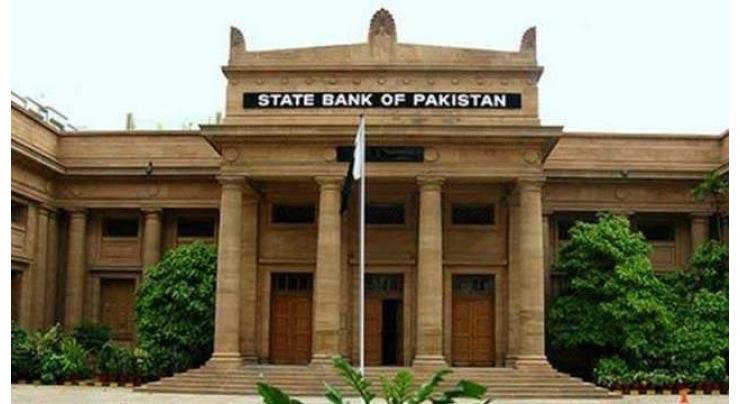
SBP Decides To Maintain Policy Rate At 9.75 Percent
Abdullah Hussain (@Abdulla99267510) Published January 24, 2022 | 05:52 PM

The MPC had considered the measures taken to lower inflation and keep the ongoing economic recovery sustainable.
KARACHI: (UrduPoint/UrduPoint / Pakistan Point News-Jan 24th, 2022) The Monetary Policy Committee (MPC) on Monday decided to maintain the policy rate at 9.75 percent, in line with the forward guidance provided in the last monetary policy statement.
The MPC had considered the measures taken to lower inflation and keep the ongoing economic recovery sustainable. These measures include a cumulative 275 basis point increase in the policy rate, higher bank cash reserve requirements, regulatory tightening of consumer finance, and curtailment of non-essential imports.
Since the last meeting on 14th December 2021, several developments suggest that these demand moderating measures are gaining traction and have improved the outlook for inflation. Recent economic growth indicators are appropriately moderating to a more sustainable pace. While year-on-year headline inflation is high and will likely remain so in the near term due to base effects and energy prices, the momentum in inflation has slowed with month-on-month inflation flat in December compared to a significant rise of 3 percent in November. Inflation expectations of businesses have also declined considerably. The current account deficit appears to have stopped growing since November and the non-oil current account balance is expected to achieve a small surplus for FY22. Finally, and importantly, the enactment of the recent Finance (Supplementary) Act, 2022 represents significant additional fiscal consolidation compared to the budget and has lowered the outlook for inflation in FY23.
Looking ahead, and against the backdrop of these developments that have improved the inflation outlook, the MPC was of the view that current real interest rates on a forward-looking basis are appropriate to guide inflation to the medium-term range of 5-7 percent, support growth, and maintain external stability. If future data outturns require a fine-tuning of monetary policy settings, the MPC expected that any change would be relatively modest.
In reaching its decision, the MPC considered key trends and prospects in the real, external and fiscal sectors, and the resulting outlook for monetary conditions and inflation.
Real sector
The economic recovery underway over the last 18 months continues, with its pace moderating from a rebased estimate of 5.6 percent in FY21. Since the last meeting, year-on-year growth rates of several high frequency demand indicators either stabilized or slowed, including cement dispatches and sales of petroleum products, tractors and commercial vehicles. On the supply side, LSM production decelerated to 3.3 percent (y/y) in July-November 2021, partly reflecting a high base-effect as well as higher input costs, while electricity generation stabilized. Similarly, there has been some easing in the momentum of imports and tax revenue growth. Prospects remain favourable in agriculture, with an improved Rabi crop outlook offsetting reports of lower cotton output. Overall, growth in FY22 is expected around the middle of the forecast range of 4-5 percent, slightly lower than previous expectations in light of moderating demand indicators and higher base effects from the upward revision in last year’s growth rate. Risks to the outlook include, on the domestic front, the current growing Omicron wave and, on the external front, the possibility of faster than anticipated tightening by the US Federal Reserve and geopolitical events in Europe that may have implications for global financial conditions.
External sector
Through the first half of FY22, the current account deficit has reached $9 billion.
Based on PBS data, imports rose to $40.6 billion, up around 66 percent (y/y), with energy imports and Covid vaccines accounting for more than half the rise. Encouragingly, imports excluding energy and vaccines have stabilized in the last two months. Exports grew by nearly 25 percent (y/y) to reach $15.1 billion, buoyed by record-high shipments of textiles as well as strong rice exports. Meanwhile, remittances rose by 11.3 percent (y/y) to an all-time high of $15.8 billion during the first half of the fiscal year. Looking ahead, the current account deficit is expected to decline through the remainder of FY22, as import growth slows in response to a normalization of global commodity prices and the fuller impact of demand-moderating measures. Indeed, the non-oil current account deficit is less than one-fourth the record levels reached during the first half of FY18. The current account projection is subject to risks on both sides. On the one hand, the deficit could be larger if global commodity prices take longer to normalize. On the other, it could be smaller if the fiscal consolidation associated with the Finance (Supplementary) Act has a faster and more pronounced impact on demand.
Fiscal sector
During the first half of FY22, FBR tax collections grew strongly by 32.5 percent (y/y). As a result, the fiscal deficit shrank to 1.1 percent of GDP during July-October FY22, compared to 1.7 percent of GDP during the same period last year. The Primary surplus also improved by 0.1 percentage points to 0.4 percent of GDP. Looking ahead, with the passage of the Finance (Supplementary) Act that withdraws certain tax exemptions, the fiscal deficit is projected to be around 0.5 percent of GDP lower than previously expected for FY22. Together with recent policy rate increases and accounting for the usual lagged impact of fiscal measures, this additional fiscal consolidation should help further moderate the pace of domestic demand growth, and thus improve the outlook for inflation and the current account in FY23.
Monetary and inflation outlook
During the first half of FY22, private sector credit cumulatively grew by 13.4 percent, largely driven by increased demand for working capital loans especially by rice, textile, petroleum and steel industries. Since the last meeting, both short and long-term secondary market yields, benchmark rates and cut-off rates in the government’s auctions declined significantly, in line with the forward guidance provided by the MPC and the conduct of 2-month open market operations by the SBP.
While headline and core inflation rose in December, both the sequential momentum of inflation and inflation expectations of businesses fell significantly. Together with low base effects, one-off cost-push pressures from energy tariff increases and the removal of tax exemptions in the Finance (Supplementary) Act are likely to keep year-on-year inflation elevated over the next few months, close to the upper end of the average inflation forecast of 9-11 percent in FY22. However, during FY23, inflation is expected to decline toward the medium-term target range of 5-7 percent more quickly than previously forecasted as demand-side pressures wane faster due to the Finance (Supplementary) Act and recent moderation in economic activity indicators. The MPC will continue to carefully monitor developments affecting medium-term prospects for inflation, financial stability, and growth.
Related Topics
Recent Stories

Pakistan marks World Press Freedom Day

High-level Saudi business delegation due on May 5

Stocks heat up as US labour market cools

President approves Tax Laws (Amendment) Bill 2024

Implementation of merit, justice to oppressed segments top priorities: CPO

Overseas Kashmir community delegation calls on AJK President, discusses latest s ..

Govt believes in freedom of press: Amir Muqam

Labour urges UK election after Tory losses

Health authorities asked for action against alleged illegal tenders at Services ..

Spain scraps national bullfighting prize sparking debate

Lahore High Court (LHC) Chief Justice Malik Shahzad Ahmad Khan visits Rawalpindi ..

ATC extends interim bail of PTI founder in 3 cases
More Stories From Business
-
CCP approves scheme of arrangement for restructuring of PIACL
2 hours ago -

High-level Saudi business delegation due on May 5
3 hours ago -

Stocks heat up as US labour market cools
3 hours ago -

Planning minister stresses need for establishing digital corridor
4 hours ago -

Burj Solar install Pakistan´s first distributed generation Wind Power project
4 hours ago -

TEVTA’s BoD decides capacity building, adoption of frugality
4 hours ago
-

US hiring slows more than expected in sign of cooler market
4 hours ago -

Stocks heat up as US labour market cools
6 hours ago -

Stocks heat up as US labour market cools
6 hours ago -

US hiring slows more than expected in sign of cooler market
6 hours ago -

PSX turns bullish, gains 1,244 points
7 hours ago -
Finance Minister for measures to enhance tax to GDP ratio
8 hours ago















